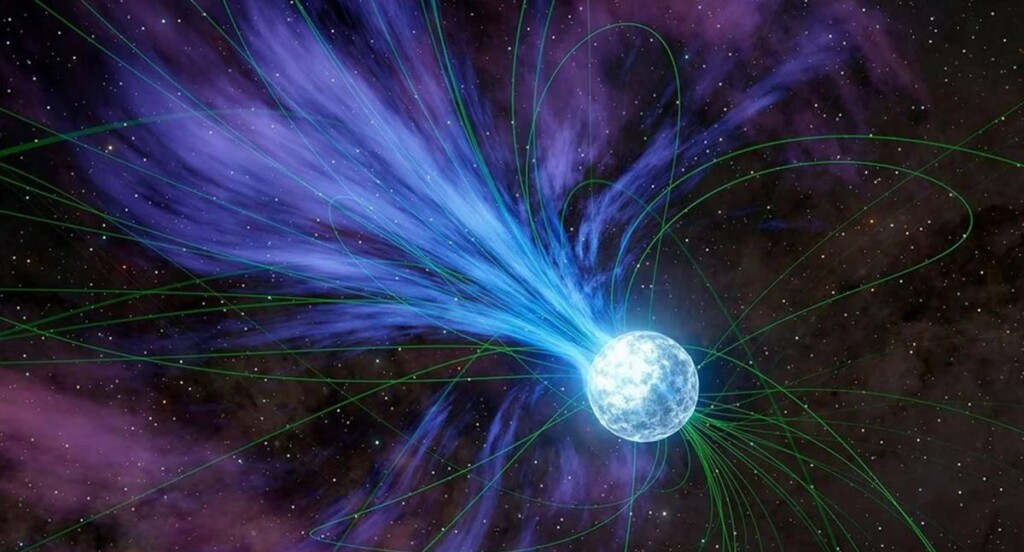 This artist’s concept depicts a magnetar releasing material into space. The magnetic field lines, shown in green, influence the movement of charged material around the magnetar – credit, NASA/JPL-Caltech
This artist’s concept depicts a magnetar releasing material into space. The magnetic field lines, shown in green, influence the movement of charged material around the magnetar – credit, NASA/JPL-CaltechIt’s long been suspected to the point of certainty that heavier elements like gold are created inside supernovae, and that over the billions of years Earth has existed, the dust from these explosions swept much of the periodic table onto it.
But a new hypothesis has been developed that may describe another way that the universe put the Au in Australia.
Out in the cosmos there are objects known as neutron stars, or pulsars, which are the unfathomably dense (one teaspoon of their material would weigh one-billion tons on Earth) remnants of exploded stars.
Fascinating objects, pulsars spin at incredibly fast speeds and release constant streams of clear radio waves that have been used as a method for interstellar coordinate calculation. Some pulsars carry magnetic fields one trillion times more powerful than Earth’s, and are called magnetars because of it.
It’s these that Anirudh Patel, lead author of a new study published Tuesday in the Astrophysical Journal Letters, believes could be the another producer of gold in the universe.
“It very cool to think about how some of the stuff in my phone or my laptop was forged in this extreme explosion (over) the course of our galaxy’s history,” Patel told CNN.
Just like on Earth, magnetars sometimes experience instability—so-called “starquakes.”
“Neutron stars have a crust and a superfluid core,” study coauthor Eric Burns, assistant professor and astrophysicist at Louisiana State University in Baton Rouge, told CNN in an email.
“On magnetars these starquakes produce very short bursts of X-rays. Just like on Earth, you have periods where a given star is particularly active, producing hundreds or thousands of flares in a few weeks. And similarly, every once in a while, a particularly powerful quake occurs.”
It’s supposed by some of Patel’s coauthors, including his PhD advisor Professor Brian Metzger that during these powerful starquakes, ejections of the neutron star crust occur, and would be a prime candidate for heavier elements like gold, uranium, and iron.
Magnetars are also believed to have formed very early on in the history of the universe, perhaps as early as 200 million years after the Big Bang. Evidence of heavy element creation was theorized by Patel and Burns to be identifiable in gamma ray radiation from a large magnetar ejection.
HOW DIAMONDS ARE FORMED: Huge Black Diamond Sold for $4.3 Million–and No One Knows Where it Came From or How it Was Formed
Burns looked at previously gathered data of a giant starquake from a magnetar from 2004, captured by the now-retired International Gamma-Ray Astrophysics Laboratory mission. Back then, astronomers collected and isolated the signal of a gamma ray, but didn’t know how to interpret the data.
That gamma ray’s characteristics matched predictions in Professor Metzger’s previous work on what the creation and distribution of heavy elements would look like in a giant magnetar flare.
INTERSTELLAR WEALTH: Mercury Could Have A Layer of Diamonds 11 Miles Thick Beneath the Surface
The researchers believe that big starquake ejections could be responsible for up to 10% of elements heavier than iron in the Milky Way galaxy.
It’s enough to change one’s perspective of the ring around their left-hand finger, for example—that not only will it never corrode and always be able to be smelted back into pure gold, but it was created to be such a unique treasure via the seismic perturbations on the densest objects in the universe.
SHARE This Interstellar Story With Your Friends On Love Science…
Source link

